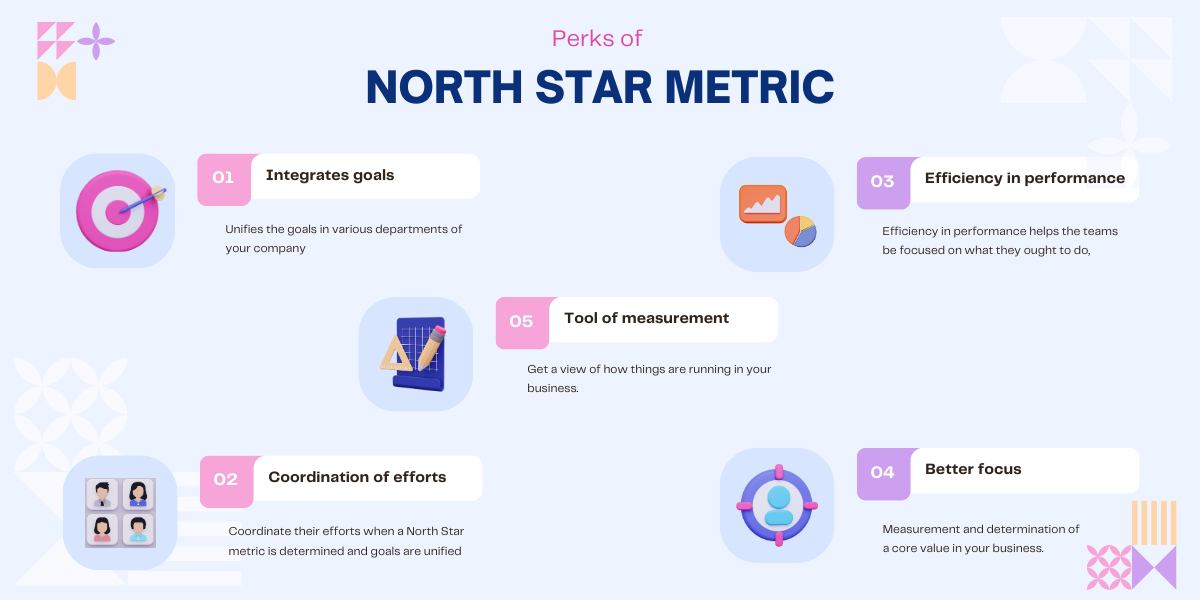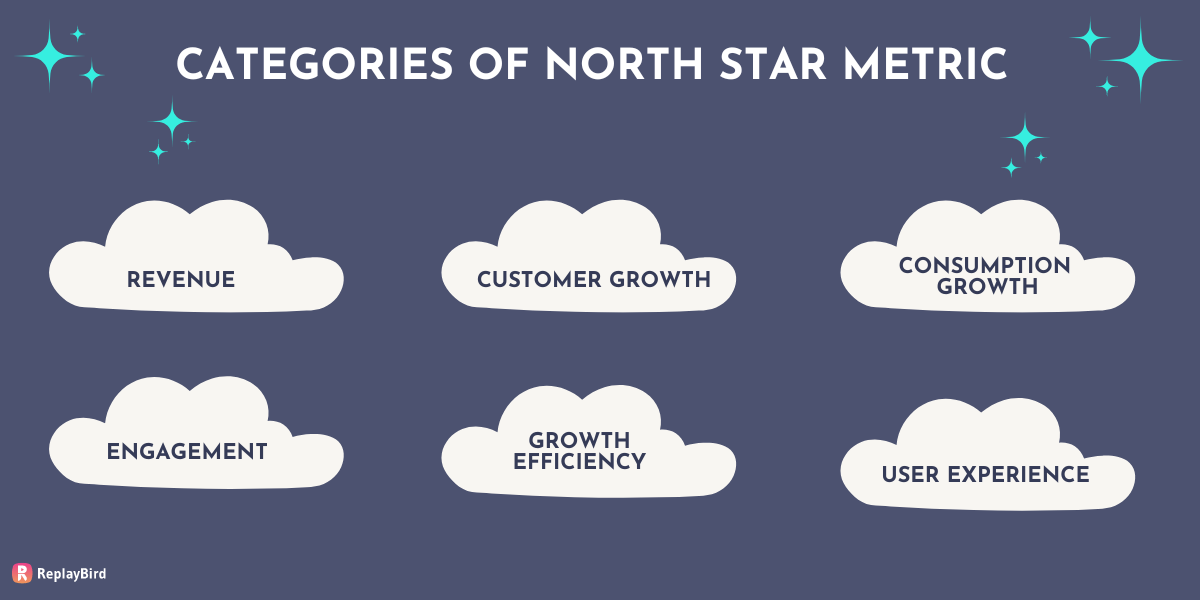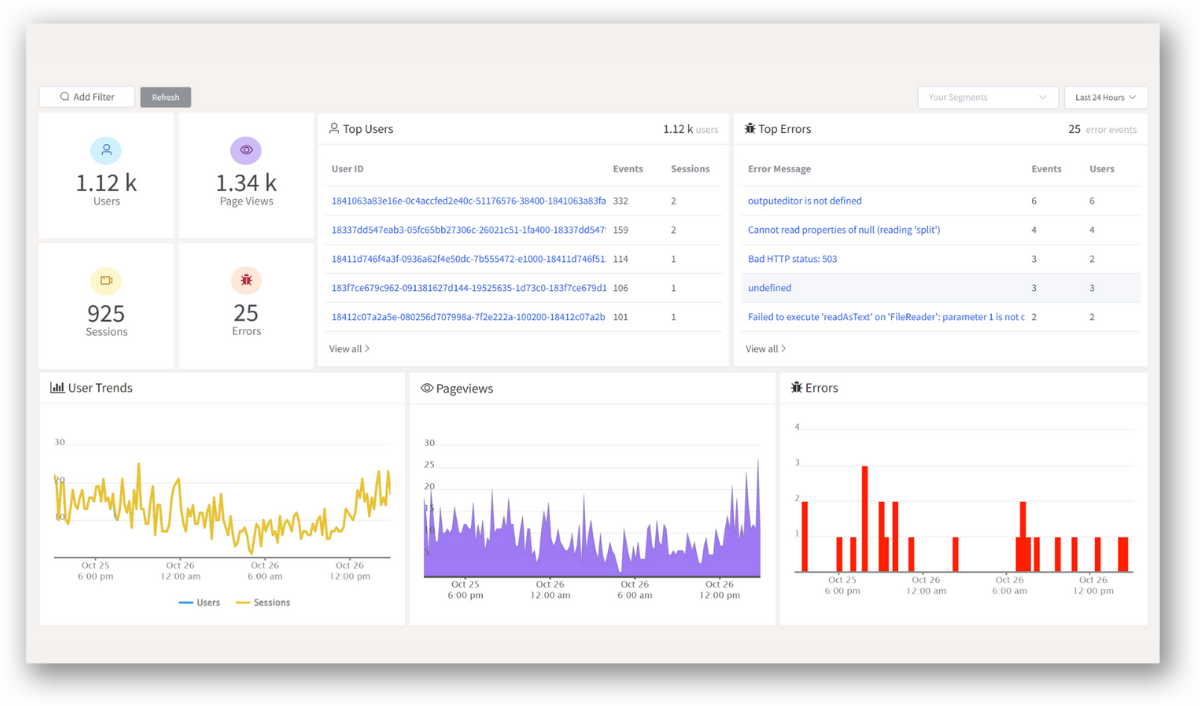North Star Metric is a significant concept when creating targets and measuring the success of organizations. It is a single indicator that gauges a company's performance in meeting its overall goal and vision.
Businesses that use a North Star Metric may focus on what genuinely matters for their success and prioritize their efforts accordingly.
In this blog article, we will look into North Star Metrics and why they are significant for organizations.
- What is a North Star Metric?
- Why the North Star metric?
- Perks of North Star Metric
- Can a company have more than one North Star metric?
- Components of North Star Metric
- How do you choose your North Star metric?
- Categories of North Star Metric
- Examples of North Star Metric from popular companies
What is a North Star Metric?
A North Star Metric is the one metric that predicts the core value which is delivered by your business. For instance, customer retention rate and customer lifetime value could be the North Star metrics of a company when they are performing well in those areas.
Moreover, it could be thought of as a key measure of success in a business. It has gotten its name "North Star" since the North Star in the sky appears to be standing still in spite of any weather or part of the day. It has a consistent position in the sky, unlike the other stars.
Why the North Star metric?
North Star Metric focuses on the core values of a business. Due to this reason, it can be a useful tool to make your employees focus on one important aspect of achieving your goals.
There are many developments in the departmentalization of a company that might lead to differences in goals or ways of working. To avoid this clash, North Star Metric plays an important role in bringing together the efforts of various departments in a business.
North Star Metric integrates goals by focusing on an essential value of the business. This avoids duplication of work, thereby contributing to efficient performance.
North Star Metric has the following objectives:
- Avoids duplication of efforts
- Unification of goals
- Efficient administration
- Coordination of departments/teams
- Simplification of business strategies
North Star Metric helps the company understand its values better, which contributes to streamlining goals.
Furthermore, business strategies could be easily formulated when the core values of the business are determined. In addition, it guides the business in the right direction, acting as a pathway.
Perks of North Star Metric
Primarily, North Star Metric helps the business stay focused on its goals. Let's see the additional benefits it provides.

1. Integrates goals
North Star Metric avoids clashes due to differences in goals. Rather, it unifies the goals in various departments of your company through a common focus on the company's core values. This helps keep teams and organizations focused and working towards the same end goals.
With North Star Metric, teams can easily monitor and measure progress towards those goals, allowing for better decision making, greater resource allocation, and ultimately, improved performance.
2. Coordination of efforts
One major perk of utilizing the North Star Metric is its ability to streamline the coordination of efforts and align teams towards a shared goal. When goals are integrated, efforts are too. Various teams in your company can coordinate their efforts when a North Star metric is determined, and goals are unified.
This integrates efforts, hence leading to synergies. By clearly defining the main objective, businesses are able to ensure that all teams are in sync, eliminating overlap and redundancy while providing a comprehensive overview of the big picture.
This improved level of coordination helps to drive efficiency, productivity and overall results, providing a strong foundation for future success.
3. Promotes efficiency in performance
When core values are identified, efforts can be clearly determined. This type of clarity helps the teams be focused on what they ought to do, thereby leading to efficiency in performance.
By having a clear understanding of the key performance indicators driving their business, businesses can make better decisions and improve performance over time. North Star Metric also provides a great way to identify areas of improvement and to make the most out of available resources.
Additionally, the insights gained from the North Star Metric can help to inform strategic decisions and long-term planning. The ultimate goal of North Star Metric is to give businesses the data-driven insights needed to make informed decisions and to maximize performance.
4. Better focus
North Star Metric is a vital factor that helps you to get your focus and be on the right track in achieving your goals. Measurement and determination of a core value in your business could be the key to your focus on achieving your goals.
You can prioritize where to spend your time and resources to achieve your desired result. With a clear focus on the big picture, you can make the right decisions to maximize your potential and drive growth. Additionally, having a single unified metric allows everyone to work towards a common goal, thus improving communication and collaboration among teams.
With the North Star Metric, you can also measure progress and performance more accurately as well as track the impact of changes. All of these aspects lead to improved results and efficiency in the long run.
5. Tool of measurement
North Star Metric provides an overview of how your company is performing. It measures the performance of your company, thereby helping you get a view of how things are running in your business.
This metric can provide a great insight into the performance of a company, team, or individual, and has a number of benefits associated with its use. Firstly, the North Star Metric allows for organizations to focus on the most important metrics and measurements, which can help streamline processes and increase efficiency.
Examples
For a retail business, "a number of orders delivered" could be a North Star metric. This could be so since the important goal of an e-commerce company is to complete a high number of orders successfully to earn revenue. Meeting the sales target is achieved through order completion for an e-commerce business.
For a subscription-based business such as OTT (over-the-top) platforms, "the number of subscriptions" could be a North Star metric. This captures the customers just like session replay, who have subscribed to your digital platform, which in turn dictates your revenue.
For social media networks such as Instagram or Facebook, "a number of account holders" could be a North Star metric. It could be their key metric since it indicates critical actions in value-adding aspects of the business.
Can a company have more than one North Star metric?
Yes, a company can have one to three key product analytics on which it can focus. Nowadays, companies have different ecosystems and complex organizational structures.
Hence, a singular focus would not be helpful for the company. An exceptional focus on one metric when there is a huge ecosystem in the company would lead to heedless efforts.
Therefore, a company can hold on to more than one metric but limit it to a maximum of three because it has a large ecosystem. Otherwise, a company can have a single North Star metric in cases where it has a smaller ecosystem.
Components of North Star Metric
Every North Star metric has three components attached to it. They are as follows:
- Value - It refers to what you are measuring. It is the additional value unit of your business. It is a quantifiable unit of value.
- Quality - It refers to the units that can actually add value to your business.
- Frequency - It refers to the number of times a value-adding action takes place.
Moreover, North Star Metric consider the following aspects:
- Acquisition - The rate at which your business acquires customers. Also, it is the number of people your business has reached through your strategies.
- Retention - It refers to the retained customers who have stayed loyal. This could occur as a result of their showing interest in and like the products or services you have offered.
- Monetization - This refers to a revenue-generating aspect of the business for which you work. Profit maximization is the main goal of any business. For an e-commerce business, certain actions by customers alone lead to revenue generation.
For example, a complete purchase through online orders leads to gaining revenue, whereas the act of adding items to a cart, creating a wishlist, or visiting a website does not monetize your business.
How do you choose your North Star metric?
Choosing a North Star metric is a vital task for a business since it portrays the integration of efforts and goals across the company in order to achieve goals and objectives.
Let us look at how you can choose your North Star metric in three steps.
#1 Defining value
How you define your unit of value depicts your goal. What value you are going to create is an inherent task. Finding out and defining "what" we mentioned here is the first step to choosing your North Star metric.
This unit of value should be applicable to the rates of acquisition, retention, and monetization aspects. The unit you choose must add value in terms of the following:
- Acquiring new customers
- Retaining the existing customers
- Attract revenue
#2 Determine the quality
The qualitative aspect of measurement must be set for the actions that are meaningful to your business. Not all actions by customers add value to your company. Quality actions that generate revenue create an impact on your business and growth.
Hence, establishing the quality of your unit of value is the second step to choosing your North Star metric. For an e-commerce business, the number of orders delivered could be a meaningful measure. The quality you establish must add value in terms of the following:
- For acquiring customers, quality could be defined in terms of their behavior and level of monetization.
- For retaining customers, quality lies in how your company describes "active users."
- For monetization, quality lies in defining the various aspects of generating revenue. It could be whether you are looking for consistent revenue or non-consistent revenue. Also, you must specify the way you look at your revenue.
#3 Determining the frequency
It refers to the timeframe of observing the behavior you have defined, i.e., value-adding aspects. The frequency could be measured in terms of:
- For acquisition, your product's consideration cycle in buyers' stages could be the frequency you can consider.
- For retention, the frequency of customers using your product could be considered.
- For monetization, the frequency of billing could be considered.
Categories of North Star Metric

The companies can choose from the six categories of the North Star Metric based on their business model, use, and growth of products/services. Let's walk through them briefly.
- Revenue - Here, the revenue being generated is the metric for companies. You can choose revenue as the focus of your business so as to attain success or growth.
- Customer growth - It refers to the focus on a number of customers who add value to your business. You can work with customers who generate your revenue through purchases, subscriptions, or any other mode of payment.
- Consumption growth - This focuses on the depth of your product usage. It could denote the users' interest in, a likeness to, or a response to the products or services you offer.
- Engagement growth - This focuses on active users on your website or application and performs activities that add value. Examples could be a complete purchase, subscriptions, etc.
- Growth efficiency - It refers to a focus on the growth aspect of the business. It is a measure of the efficiency of spending and earning money.
- User experience - It refers to a focus on providing the customers with the best product experience offered and the website/application experience. This enhances customer satisfaction, which leads to loyalty and retention, thereby making it an excellent metric to work on.
Examples of North Star Metric from popular companies
Let us look at the real-time examples of companies that we know and their North Star metrics.
#1 Social media platforms
- Facebook, Snapchat, and Pinterest focus on user engagement as their metric. They focus on improving the number of users or account holders for their platforms since they run on ad traffic. These networks generate revenue through web traffic, so they need to capture user engagement as their guiding metric.
#2 Subscription-based business
-
Netflix considers the consumption of “median view hours per month" as their North Star metric.
-
Whereas Spotify focuses on customer experience optimization, customer growth, and consumption for their North Star metric. It is to be noted that Spotify is both a subscription-based and an ad-based business.
-
Amazon Prime Video considers the "number of active Prime subscribers" as their North Star metric.
#3 Marketplaces
- Uber considers the volume of transactions as their north star metric. This refers to the rides taken by the customers, which determine their consumption.
Conclusion
North Star is a guiding metric that enables you to drive your focus on your goals and objectives. It helps you to prioritize what matters most to your company. Integration of efforts and goals is made possible by capturing a meaningful metric on products.
Furthermore, the efficiency of performance is assured through the selection of a guiding metric. We know that metrics is an important tool for measuring your performance and success, which is why choosing the right metric as a guiding factor fuels your performance.
In conclusion, North Star Metric makes your path to success efficient and effective, thereby keeping you focused on your targets.
ReplayBird - Driving Revenue and Growth through Actionable Product Insights
ReplayBird is a digital experience analytics platform that offers a comprehensive real-time insights which goes beyond the limitations of traditional web analytics with features such as product analytics, session replay, error analysis, funnel, and path analysis.
With Replaybird, you can capture a complete picture of user behavior, understand their pain points, and improve the overall end-user experience. Session replay feature allows you to watch user sessions in real-time, so you can understand their actions, identify issues and quickly take corrective actions. Error analysis feature helps you identify and resolve javascript errors as they occur, minimizing the negative impact on user experience.

With product analytics feature, you can get deeper insights into how users are interacting with your product and identify opportunities to improve. Drive understanding, action, and trust, leading to improved customer experiences and driving business revenue growth.
Try ReplayBird 14-days free trial
Further Readings:









